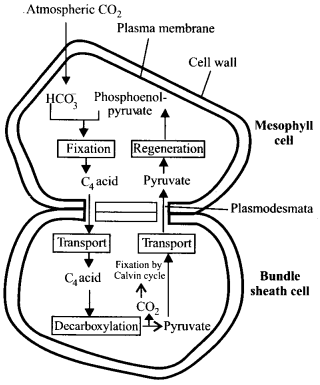To establish a proton gradient across the thylakoid membrane, the protons are provided by:
1.
Glucose
2.
Chlorophyll
3.
Membrane proteins
4.
Water
Heme and iron-sulfur complexes in photosynthesis:
1. act as reducing agents
2. act as oxidizing agents
3. both oxidize and reduce during electron transport
4. are needed only in respiration but not in photosynthesis
Identify the correct statement:
| 1. | The pH within the thylakoid is less than that of the stroma. |
| 2. | The pH of the stroma is higher than that of the other two measurements. |
| 3. | The pH of the stroma is higher than that of the thylakoid space but lower than that of the cytosol. |
| 4. | The pH of the thylakoid space is higher than that observed anywhere else in the cell. |
The pathway shown in the figure will be seen in:
1. plants
2. CAM plants
3. plants
4. All photosynthetic plants
Carbon dioxide fixation will be inhibited by oxygen in:

1. cell I only.
2. cell II only.
3. neither cell I nor cell II.
4. both cell I and cell II.
Radioactive carbon [] was fed to a plant during the day and after a short time was traced to oxaloacetate. The plant used in the experiment will be:
| 1. | C4 plant | 2. | C3 plant |
| 3. | CAM plant | 4. | carnivorous plant |
plants are able to photosynthesize with no apparent photorespiration because of:
1. absence of Calvin cycle.
2. use of PEP carboxylase for primary carbon dioxide fixation.
3. absence of RuBisCO.
4. presence of tissues that do not require oxygen.
CAM plants:
1. fix carbon dioxide during the night into organic acids.
2. fix carbon dioxide into organic acids in the bundle-sheath cells during the day.
3. fix carbon dioxide into pyruvate in the mesophyll cells during the night.
4. use both photosystems I and II at night.
The process of photosynthesis has lower efficiency if photorespiration occurs because of the reduced formation of:
| 1. | AcetylCoA | 2. | 3-phosphoglycerate |
| 3. | ATP | 4. | RuBP |
Both and CAM pathways are regarded as compromises. The reason for this would be:
1. Both pathways lead to reduction of photosynthesis to enable water conservation.
2. To maintain high photosynthetic levels compromises on water loss and CAM compromises on loss of carbon.
3. Both minimize photorespiration and optimize the Calvin cycle.
4. To maintain high photosynthetic levels CAM compromises on water loss and C4 compromises on loss of carbon.







